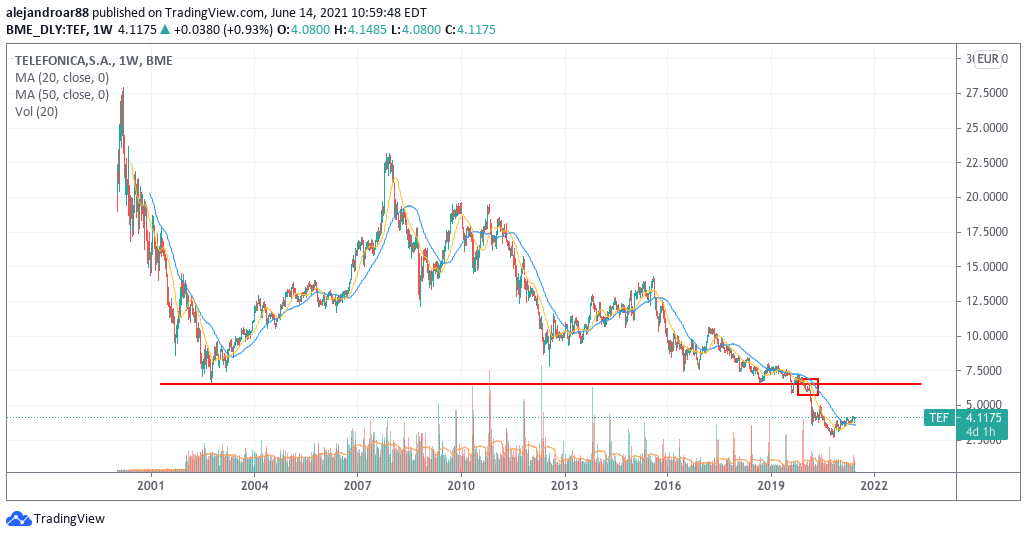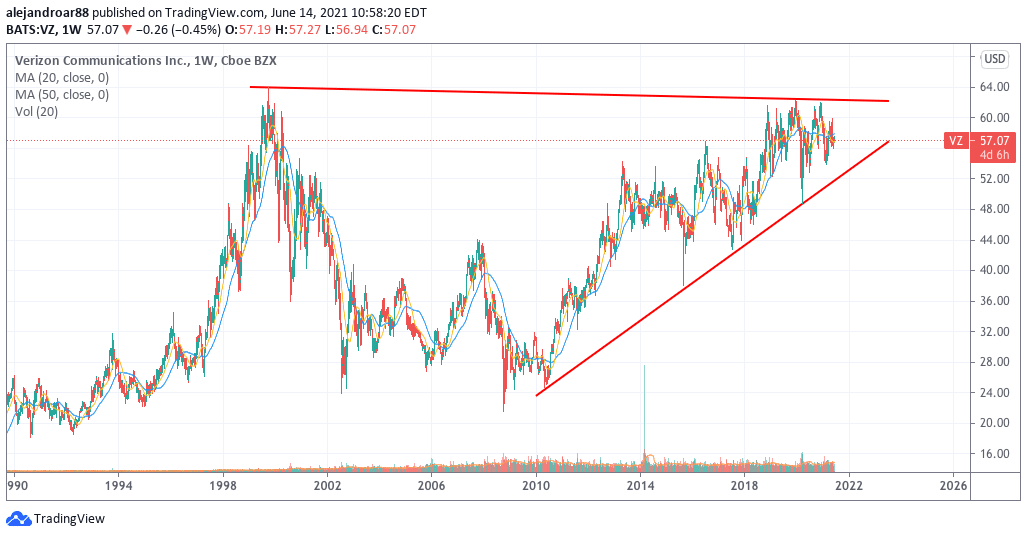5 Best High Dividend Stocks to Buy in June 2021
Please note that we are not authorised to provide any investment advice. The content on this page is for information purposes only.
In an environment of near-zero savings rates and low-coupon bonds, dividend stocks have emerged as a suitable go-to instrument for those seeking to produce a fixed income out of their investments.
However, picking the best high dividend stocks is not as simple as it seems since the company’s ability to maintain – or even grow – that dividend in the future is more important than its track record.
To help you in shortlisting the best candidates out there for a dividend-focused investing strategy, the following list provides you with 5 names that offer the combination of an attractive yield along and high odds of maintaining or growing their current distributions.
Telefonica S.A. (TEF)

Dividend Yield: 9.6%
Telefonica SA (TEF) is a huge telecom company based in Spain with operations across the globe that generated over $50 billion in revenue last year. The company currently offers an attractive 9.6% dividend yield that has been paid in stock for the past two semesters following a policy change from the company in light of the COVID-19 situation.
Although this kind of dividend is not as attractive as a cash dividend, investors can always cash in the extra shares they receive by selling them.
By the end of 2020, the company reported a total of €6.6 billion in free cash flows for the period while it distributed around €2 billion in stock dividends last year. That results in a coverage ratio of 3 times and there is the added possibility that the Board of Directors could move to approve the resumption of the firm’s regular cash dividend this year as the COVID-19 situation progressively starts to become an item in the rearview mirror.
Meanwhile, the firm’s balance sheet seems quite robust to withstand a short-term blow to its bottom-line results while possibly maintaining the dividend as Telefonica displays a long-term-debt-to-assets ratio of around 65%. Moreover, the firm had €7.5 billion in cash and equivalents by the end of last year.
British American Tobacco Plc (BTI)
Dividend Yield: 7.4%
British American Tobacco (BTI) is one of the largest tobacco companies in the world. It ended 2020 with sales of $35.25 billion while distributing almost $6.5 billion in dividends. This stock’s high dividend yield is primarily supported by the negative momentum that the sector is going through as a result of lower consumption levels. However, the firm’s financials remain strong and its dividend seems fairly stable based on BTI’s cash flow generation capacity.
The company currently offers a 7.4% dividend yield while it generated as much as $12.5 billion in free cash flows during 2020, which results in a dividend coverage ratio of almost 2. Meanwhile, the firm has been able to grow its bottom-line profitability lately at a decent rate, with BTI’s net income moving from $4.9 billion in 2014 to $8.7 billion last year.
This earnings growth supports the continuation of the firm’s free-cash-flow generation capacity, especially as capital expenditures remain quite low, which makes BTI what financial analysts would commonly call a cash cow. Moreover, the firm held more than $4.6 billion in cash and equivalents by the end of last year.
GlaxoSmithKline Plc (GSK)
Dividend Yield: 5.7%
GlaxoSmithKline (GSK) is a British pharmaceutical giant whose sales landed at £34.1 billion last year while the company was able to distribute as much as £4 billion in dividends last year at 80p per share – which results in an attractive 5.7% yield based on the price of the stock this morning.
Glaxo’s management expects to maintain this dividend unchanged for its 2021 fiscal year. This intention is backed by the firm’s cash flow generation capacity as GSK has consistently generated free cash flows of £5 to £6 billion in the past three years or so.
Based on that historical track record, the company should have no problem honoring its dividend policy as it displays a dividend coverage ratio of 1.5. Additionally, the company had more than £6.3 billion in cash and equivalents by the end of 2020.
Verizon Communications (VZ)

Dividend Yield: 4.4%
Verizon Communications (VZ) is a global telecom mammoth that produced $128.3 billion in revenues in 2020 while displaying a relatively stable outlook when it comes to its dividend distribution amid a solid free cash flow generation capacity and a sizable cash stockpile of $22.17 billion – which is two times the firm’s 2020 total dividend paid.
During the third quarter of 2020, the Board of Directors of Verizon ramped up the firm’s quarterly dividend by 2%, making this the fourteenth consecutive year in which the firm has approved a quarterly increase.
Based on the company’s financial situation, cash flow generation capacity, and business outlook, Verizon should be able to at least maintain its current quarterly dividend unchanged, which results in a 4.4% yield based on quarterly distributions of $0.6275 per share.
Last year, the company generated around $13 billion in free cash flows, which results in a 1.3 dividend coverage ratio. Such a ratio has been even higher in the preceding years and may have been temporarily depressed by COVID-related setbacks in the firm’s business volumes.
The Western Union Company (WU)
Dividend Yield: 3.8%
With more than 170 years of history, the Western Union Company (WU) has helped millions of customers in transferring money across the world through its long-standing business model supported by a network of thousands of branches located in over 200 different countries.
Last year, the firm’s sales ended the year at $4.8 billion and although revenue growth has been fairly stalled for the past five years or so due to increased competition, the company is still generating a solid amount of $700 to $800 million in free cash flows that provide ample support for its annual $300 million+ dividend.
Given the firm’s solid balance sheet, which included $1.4 billion in cash and equivalents as of last year and a fairly conservative debt-to-assets ratio, the possibility that Western Union will decrease or suspend its distributions in the future seems fairly low.





